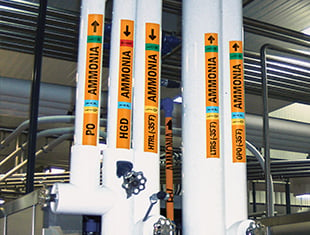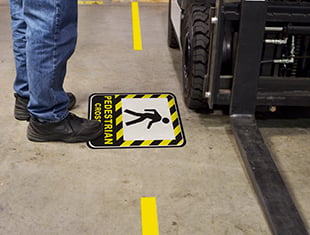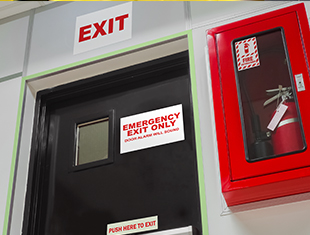Practical Pipe Marking
Webinar | Practical Pipe Marking
Practical Pipe Marking
Prepare your facility for safer, simpler, and more efficient operation, using a practical approach to pipe marking. Compliance Specialist Brian McFadden discusses what pipe marking is and why it matters, along with some of the key standards. Finally, get tips on how to implement effective pipe marking for your facility.
 20:00 MINS
20:00 MINS Presented By

Brian McFadden
Technical Writer
Compliance Specialist
Related Resources
Transcript
Webinar Preview
Contents of the Expert Pipe Marking Webinar:
- What Is Pipe Marking?
- Key Standards in the Field
- How ANSI/ASME A13.1 Works
- Practical Steps
Excerpt from the Practical Pipe Marking Webinar transcript:
In this webinar, we'll talk about:
- the basic concept behind pipe marking, and why pipe marking matters,
- some of the key standards that apply to pipe marking or provide detailed frameworks for it,
- the details of ANSI/ASME A13.1, the most important pipe marking standard for most American facilities,
- and how to actually achieve effective pipe marking in your own facility.
What Is Pipe Marking?
First, when I say "pipe marking," I mean a consciously-chosen system for labeling pipes and the assorted components that are part of a piping system within a given facility. These piping systems carry materials - air, water, fuel, waste, or any number of other products - from one place to another.
The purpose of the pipes is to carry that material; the purpose of the labels is to identify which material is in which pipe. Ultimately, that's what pipe marking is.
Why Does Pipe Marking Matter?
Providing certainty on pipe contents will have many benefits. It simplifies maintenance, and accelerates upgrades and improvements, helping to ensure that the piping system can do its job effectively.
But those benefits are dwarfed by the potential for preventing accidents. A mistake in operating, maintaining, filling, or emptying a piping system can be extremely expensive. And in addition to the monetary costs, there are also cases where getting the wrong pipe, or mixing the wrong contents, could cause serious injuries - or even death.
At a milk processing plant in Portland, Oregon, in 2012, a large delivery of a sanitizing compound containing nitric and phosphoric acids was accidentally transferred into the wrong tank. That tank already contained a mixture of sodium hydroxide and sodium hypochlorite (lye and bleach).
When the chemicals mixed, they produced a violent reaction, and released a substantial amount of chlorine gas, which is highly toxic. As a result, the facility was evacuated for the rest of the day, the delivery driver was hospitalized overnight, and eleven others were sent to the emergency room - including one person who was just driving past the facility. Both OSHA and the EPA investigated, and unclear marking was found to be a factor in the mistake.
When is Pipe Marking Mandatory?
Clearly, pipe marking is not just about efficient maintenance. It has that benefit, certainly - but pipe marking can also be an issue of life safety.
Following from this, there are some industries and materials for which pipe marking is specifically required by law. Even where no specific legal requirement is in place, though, OSHA can consider pipe marking to be part of an employer's general duty to provide a safe workplace, if any of these circumstances apply:
- the pipe contents are hazardous, or could generate a hazardous condition;
- the pipe serves a safety purpose, as part of hazard prevention or emergency response;
- the pipe's flow must be shut off, redirected, or adjusted to allow for necessary work;
- or the pipe and its contents would affect procedures during emergency response.
Those cover a very wide variety of situations. In most cases, effective pipe marking needs to be part of a facility's plan for safe operation.
Key Standards for Pipe Marking
Since pipe marking is so important, many industry groups and process experts have their own opinions on the best approach, and there are dozens of standards that cover it. Today, I'll briefly describe some of the most important ones, and I'll get into the details of the single most common standard for pipe marking in the United States.
ANSI/ASME A13.1
Let's start with that big standard: ANSI/ASME A13.1. This is published by the American National Standards Institute, with input from the American Society of Mechanical Engineers. Those are not government agencies, and ANSI/ASME A13.1 is not a law, but there are separate regulations that require certain kinds of facilities to use it; pulp and paper mills, for example, are required by OSHA to follow this standard.
Even where it's not required, though, this is the standard that's most widely used for pipe marking in American workplaces. It's been around a long time; it's well-known and well-respected. Several of the other standards are actually designed as extensions of this one. If you only remember one approach to pipe marking, this is a good choice.
To learn more about the ANSI/ASME A13.1 standard and other specialized approaches to practical pipe marking, register to watch the full webinar!
Related Resources

Ammonia Pipe Marking
Presented By Brian McFadden Technical Writer Compliance Specialist Related Resources Ammonia Pipe Marking ...
Watch Now
Productive Floor Marking
Presented By Brian McFadden Technical Writer Compliance Specialist Related Resources Floor Marking Placement ...
Watch Now
Preparing for Facility Emergencies
Presented By Brian McFadden Technical Writer Compliance Specialist Related Resources Emergency Preparation ...
Watch Now.png)





